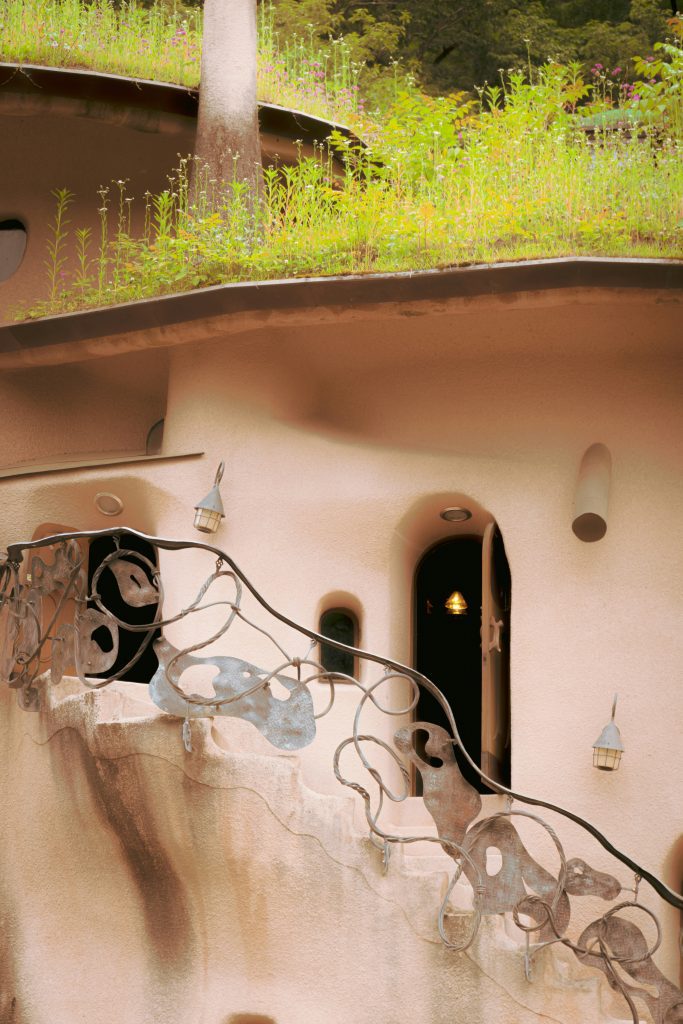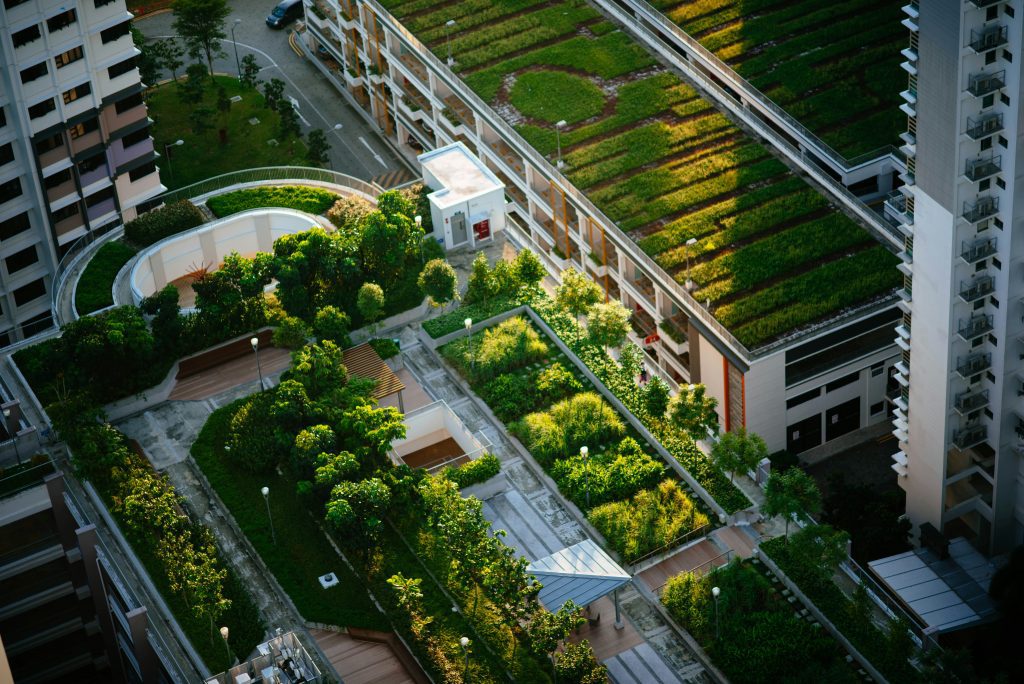Green roofing, also known as living roofing, is a sustainable building practice that involves the installation of a layer of vegetation and soil on the roof of a building. This innovative approach to roofing offers numerous environmental benefits. Firstly, green roofs help to mitigate the urban heat island effect by absorbing and retaining heat, reducing the overall temperature of the building and its surroundings.
This can lead to a decrease in energy consumption for air conditioning during the hot summer months, thereby reducing greenhouse gas emissions and lowering the carbon footprint of the building. Secondly, green roofs act as natural air filters, capturing airborne pollutants and particulate matter, which helps to improve air quality in urban areas. The vegetation on green roofs also absorbs carbon dioxide and releases oxygen through photosynthesis, contributing to the reduction of greenhouse gases in the atmosphere.
Additionally, green roofs can help to manage stormwater runoff by absorbing and retaining rainwater, reducing the strain on urban drainage systems and preventing water pollution. This can be particularly beneficial in areas prone to heavy rainfall and flooding. In conclusion, green roofing offers a range of environmental benefits, including mitigating the urban heat island effect, improving air quality, reducing greenhouse gas emissions, and managing stormwater runoff.
These benefits make green roofing an attractive option for environmentally conscious building owners and developers looking to reduce their ecological impact.
Summary
- Green roofing helps reduce urban heat island effect and air pollution
- Green roofing can increase a property’s energy efficiency and reduce heating and cooling costs
- Long-term cost savings from green roofing include reduced maintenance and extended roof lifespan
- Regular maintenance is required for green roofing, including weeding and irrigation
- Green roofing can increase property value and attract eco-conscious buyers
- Government incentives for green roofing may include tax credits and grants
- The return on investment for green roofing can be significant, especially when considering long-term savings and property value increase
The Financial Investment of Green Roofing
Longer Lifespan and Reduced Maintenance
Green roofs have a longer lifespan than conventional roofs, as the vegetation and soil layer act as a protective barrier against UV radiation, extreme temperatures, and physical damage. This can result in reduced maintenance and replacement costs over the lifespan of the building.
Insulation Benefits and Energy Savings
Furthermore, green roofs can provide insulation benefits, reducing the energy consumption required for heating and cooling. This can lead to significant cost savings on energy bills over time, making green roofing a financially sound investment. In addition, green roofs can extend the lifespan of HVAC systems by reducing the strain on them, further contributing to long-term cost savings.
A Financially Viable Option
In summary, while the initial investment in green roofing may be higher than traditional roofing systems, the long-term financial benefits, including reduced maintenance costs, energy savings, and extended lifespan of building systems, make it a financially viable option for building owners and developers.
The Long-Term Cost Savings of Green Roofing

Green roofing offers a range of long-term cost savings that make it an attractive option for building owners and developers. Firstly, green roofs provide insulation benefits, reducing the energy consumption required for heating and cooling. This can lead to significant cost savings on energy bills over time, making green roofing a financially sound investment.
Additionally, green roofs have a longer lifespan than conventional roofs, as the vegetation and soil layer act as a protective barrier against UV radiation, extreme temperatures, and physical damage. This can result in reduced maintenance and replacement costs over the lifespan of the building. Furthermore, green roofs can extend the lifespan of HVAC systems by reducing the strain on them, further contributing to long-term cost savings.
In addition, green roofs can help to mitigate the urban heat island effect, reducing the need for excessive air conditioning during hot summer months and lowering energy costs. Overall, the long-term cost savings of green roofing make it an attractive option for building owners and developers looking to reduce operational expenses and increase the sustainability of their buildings.
The Maintenance and Upkeep of Green Roofing
| Aspect | Metric |
|---|---|
| Inspection Frequency | Quarterly |
| Drainage Maintenance | Clearing debris and checking for blockages |
| Plant Health | Regular monitoring for signs of stress or disease |
| Watering | As needed, especially during dry periods |
| Weed Control | Regular removal to prevent competition with plants |
| Structural Inspection | Annually to ensure integrity of the roof |
Green roofs require regular maintenance and upkeep to ensure their longevity and effectiveness. The vegetation on green roofs needs to be regularly watered, weeded, and fertilised to maintain its health and vitality. Additionally, the drainage system on green roofs needs to be regularly inspected and cleared to prevent water pooling and potential damage to the roof structure.
Furthermore, regular inspections of the waterproofing membrane and vegetation layer are necessary to identify any potential issues or damage that may arise over time. It is important to work with experienced professionals who are knowledgeable in green roof maintenance to ensure that the roof is properly cared for and any issues are addressed promptly. While green roofs do require ongoing maintenance, when properly cared for, they can provide long-term environmental and financial benefits for building owners.
In conclusion, while green roofs do require regular maintenance and upkeep, when properly cared for, they can provide long-term environmental and financial benefits for building owners.
The Impact of Green Roofing on Property Value
Green roofing can have a positive impact on property value due to its numerous environmental and financial benefits. Buildings with green roofs are often seen as more sustainable and environmentally friendly, which can make them more attractive to potential buyers or tenants. Additionally, green roofs can contribute to improved air quality in urban areas, which can enhance the overall desirability of a property.
Furthermore, the insulation benefits of green roofs can lead to reduced energy consumption for heating and cooling, resulting in lower operational costs for building owners. This can make properties with green roofs more appealing to potential buyers or tenants looking for energy-efficient buildings with lower utility bills. Overall, the environmental and financial benefits of green roofing can positively impact property value and make buildings with green roofs more competitive in the real estate market.
The Government Incentives for Green Roofing

Financial Incentives
These incentives may include tax credits, grants, or rebates for building owners who install green roofs on their properties. Additionally, some governments offer expedited permitting processes or other regulatory incentives to encourage the adoption of green roofing.
Local Authority Support
Furthermore, some local authorities may offer financial assistance or technical support for green roof projects as part of their commitment to environmental sustainability.
Benefits for Building Owners
These government incentives can help offset the initial cost of installing a green roof and make it a more financially viable option for building owners and developers. By taking advantage of these incentives, building owners can not only reduce their environmental impact but also benefit from financial support from government agencies.
The Return on Investment for Green Roofing
The return on investment for green roofing is multifaceted, encompassing both environmental and financial benefits. From an environmental perspective, green roofs can help mitigate the urban heat island effect, improve air quality, reduce greenhouse gas emissions, and manage stormwater runoff. These environmental benefits contribute to a healthier and more sustainable urban environment.
From a financial perspective, green roofs offer long-term cost savings through reduced energy consumption for heating and cooling, extended lifespan of building systems, and lower maintenance costs. Additionally, green roofs can have a positive impact on property value due to their sustainability and energy efficiency features. When considering the long-term environmental and financial benefits of green roofing, it becomes clear that it offers a strong return on investment for building owners and developers.
In conclusion, green roofing offers a range of environmental benefits including mitigating the urban heat island effect, improving air quality, reducing greenhouse gas emissions, managing stormwater runoff, as well as long-term financial benefits such as reduced maintenance costs, energy savings, extended lifespan of building systems and increased property value. When considering these factors alongside government incentives for green roofing projects it becomes clear that it offers a strong return on investment for building owners and developers looking to reduce their ecological impact while also making sound financial decisions.
If you are considering green roofing for your home, you may also be interested in exploring the power of solar energy. This article on solar energy provides definitions, advantages, and facts about this sustainable energy source. By combining green roofing with solar energy, you can create a more environmentally friendly and energy-efficient home. For more eco-friendly home and garden tips, visit EcoFriendlyHomeAndGarden.com.
FAQs
What is green roofing?
Green roofing refers to the practice of growing vegetation on the roof of a building. This can involve the use of plants, grasses, and even small trees to create a living, breathing roof.
What are the benefits of green roofing?
Green roofing offers a range of benefits, including improved insulation, reduced energy costs, and the ability to absorb rainwater, which can help to reduce the risk of flooding. It also provides habitat for wildlife and can improve air quality.
What is the cost of installing a green roof?
The cost of installing a green roof can vary depending on factors such as the size of the roof, the type of vegetation used, and the complexity of the installation. On average, the cost can range from £75 to £200 per square meter.
What factors can affect the cost of a green roof?
Factors that can affect the cost of a green roof include the type of vegetation used, the need for additional structural support, and the level of maintenance required. The location and accessibility of the roof can also impact the cost.
Are there any long-term cost savings associated with green roofing?
Yes, green roofing can lead to long-term cost savings through reduced energy costs, extended roof lifespan, and potential tax incentives or grants for eco-friendly building practices. Additionally, green roofs can increase property value.
Are there any government incentives for installing a green roof?
Some local authorities and government bodies offer incentives, such as grants or tax breaks, for installing green roofs as part of efforts to promote sustainable building practices and reduce environmental impact. It’s worth checking with local authorities for any available incentives.


